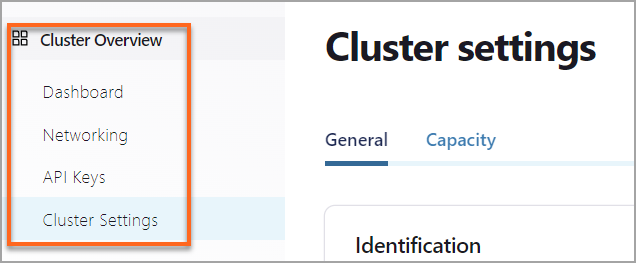Manage Kafka Cluster Configuration Settings in Confluent Cloud¶
This topic describes the default Apache Kafka® cluster configuration settings in Confluent Cloud. For a complete description of all Kafka configurations, see Confluent Platform Configuration Reference.
Considerations:
- You cannot edit cluster settings on Confluent Cloud on Basic, Standard, Enterprise, and Freight clusters, but many configuration settings are available at the topic level instead. For more information, see Manage Topics in Confluent Cloud.
- You can change some configuration settings on Dedicated clusters using the Confluent CLI or REST API. See Change cluster settings for Dedicated clusters.
- The default maximum timeout for registered consumers is different for Confluent Cloud Kafka clusters than for Confluent Platform clusters and cannot be changed.
group.max.session.timeout.msdefault is 1200000 ms (20 minutes)
Access cluster settings in the Confluent Cloud Console¶
You can access settings for your clusters with the Cloud Console.
To do so:
Sign in to your Confluent account.
Select an environment and choose a cluster.
In the navigation menu, select Cluster Overview > Cluster settings and the Cluster settings page displays.
Note
You may also see Networking and Security tabs depending on the type of cluster and how it is configured.
Change cluster settings for Dedicated clusters¶
The following table lists editable cluster settings for Dedicated clusters and their default parameter values.
| Parameter Name | Default | Editable | More Info |
|---|---|---|---|
| auto.create.topics.enable | false | Yes | |
| ssl.cipher.suites | “” | Yes | |
| num.partitions | 6 | Yes | Limits vary, see: Kafka Cluster Types in Confluent Cloud |
| log.cleaner.max.compaction.lag.ms | 9223372036854775807 | Yes | Min: 21600000 ms |
| log.retention.ms | 604800000 | Yes | Set to -1 for Infinite Storage |
To modify these settings, use the CLI or the Kafka REST APIs. For more information, see Get Started with Confluent CLI or Kafka REST API Quick Start for Confluent Cloud.
Changes to the settings are applied to your Confluent Cloud cluster without additional action on your part and are persistent until the setting is explicitly changed again.
Important
These settings apply only to Dedicated clusters and cannot be modified on Basic, Standard, Enterprise, and Freight clusters.
Enable automatic topic creation¶
Automatic topic creation (auto.create.topics.enable) is disabled (false) by default to help prevent unexpected costs. The following commands show
how to enable it. For more on this property, see broker configurations.
confluent kafka cluster configuration update --config auto.create.topics.enable=true
curl --location --request PUT 'https://<REST endpoint>/kafka/v3/clusters/<cluster-id>/broker-configs/auto.create.topics.enable' \
--header 'Authorization: Basic <base64-encoded-key-and-secret>' \
--header 'Content-Type: application/json' \
--data-raw '{
"value": "true"
}'
Restrict cipher suites¶
The following commands show how to restrict the allowed TLS/SSL cipher suites (ssl.cipher.suites).
For more on this property, see broker configurations.
confluent kafka cluster configuration update --config ssl.cipher.suites=["list-item-1,list-item-2"]
curl --location --request PUT 'https://<REST endpoint>/kafka/v3/clusters/<cluster-id>/broker-configs/ssl.cipher.suites' \
--header 'Authorization: Basic <base64-encoded-key-and-secret>' \
--header 'Content-Type: application/json' \
--data-raw '{
"value": "<int>"
}'
The valid list of ciphers includes:
TLS_ECDHE_RSA_WITH_AES_128_GCM_SHA256
TLS_ECDHE_RSA_WITH_AES_256_GCM_SHA384
TLS_ECDHE_RSA_WITH_CHACHA20_POLY1305_SHA256
Change the default number of partitions for new topics¶
The following commands show how to set the default number of partitions (num.partitions) for newly
created topics. On clusters, num.partitions allows you set a default for newly created topics. On
topics, num.partitions allows you to specify the number of partitions for a particular topic. For
more information, see topic configurations and
confluent kafka cluster configuration update.
confluent kafka cluster configuration update --config num.partitions=<n>
curl --location --request PUT 'https://<REST endpoint>/kafka/v3/clusters/<cluster-id>/broker-configs/num.partitions' \
--header 'Authorization: Basic <base64-encoded-key-and-secret>' \
--header 'Content-Type: application/json' \
--data-raw '{
"value": "<int>"
}'
Change maximum compaction lag time¶
The following commands show how to set the default maximum lag compaction time (log.cleaner.max.compaction.lag.ms) for new topics.
For more on this property, see max.compaction.lag.ms.
confluent kafka cluster configuration update --config log.cleaner.max.compaction.lag.ms=<int>
curl --location --request PUT 'https://<REST endpoint>/kafka/v3/clusters/<cluster-id>/broker-configs/log.cleaner.max.compaction.lag.ms' \
--header 'Authorization: Basic <base64-encoded-key-and-secret>' \
--header 'Content-Type: application/json' \
--data-raw '{
"value": "<int>"
}'
Change log retention time¶
The following commands show how to set the default log retention time (log.retention.ms) for new topics.
For more on this property, see retention.ms.
confluent kafka cluster configuration update --config log.retention.ms=<int>
curl --location --request PUT 'https://<REST endpoint>/kafka/v3/clusters/<cluster-id>/broker-configs/log.retention.ms' \
--header 'Authorization: Basic <base64-encoded-key-and-secret>' \
--header 'Content-Type: application/json' \
--data-raw '{
"value": "<int>"
}'
